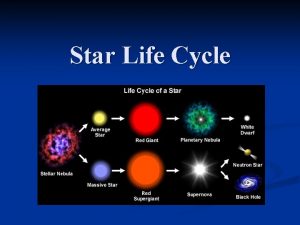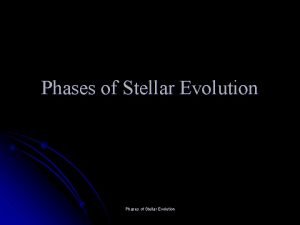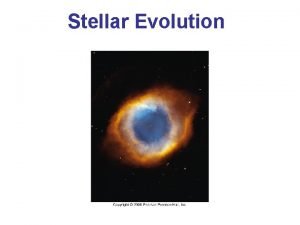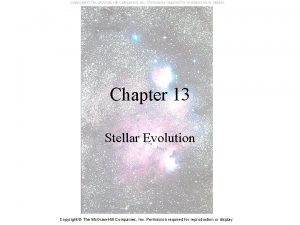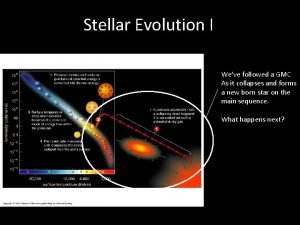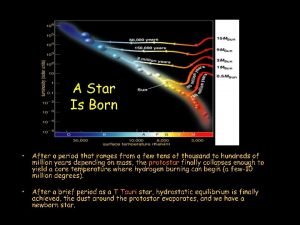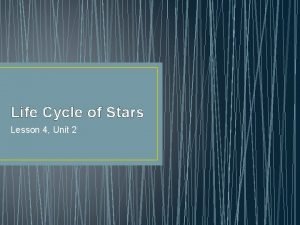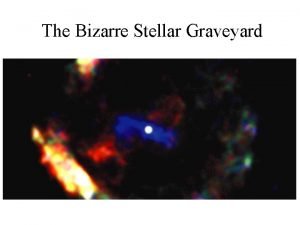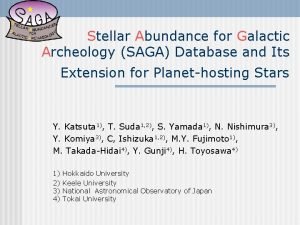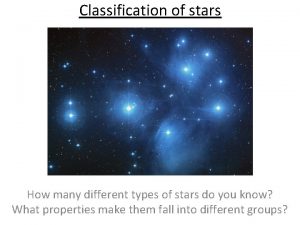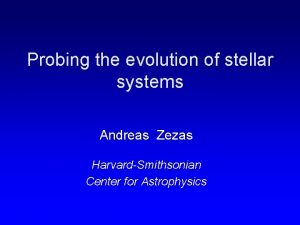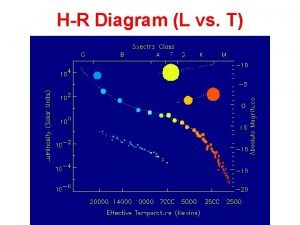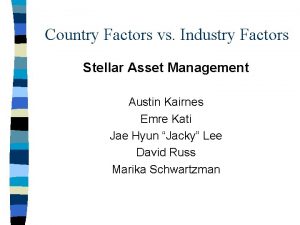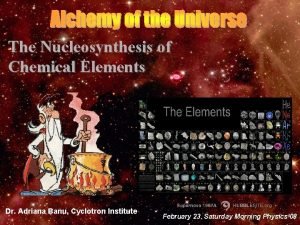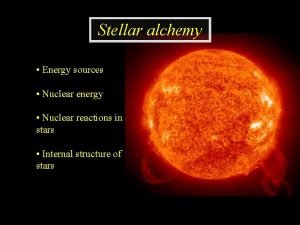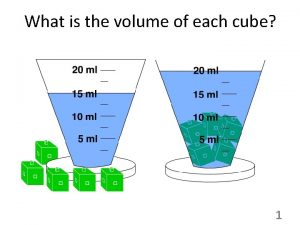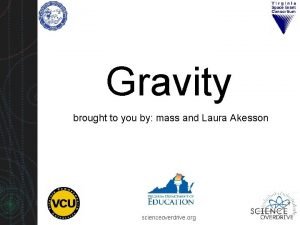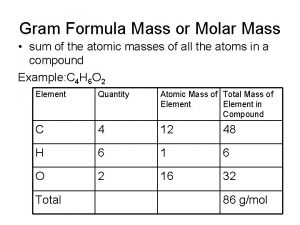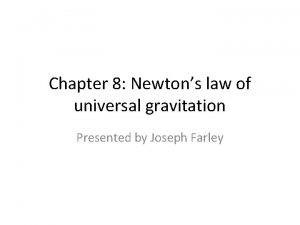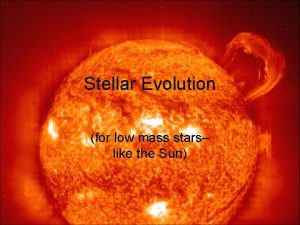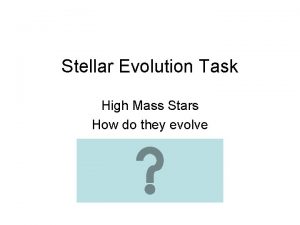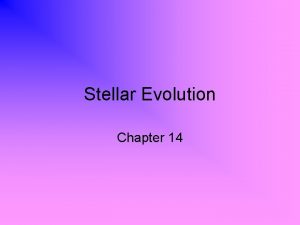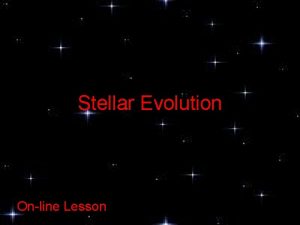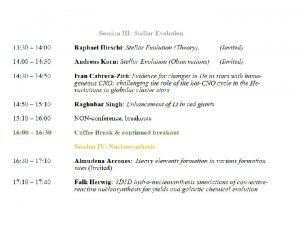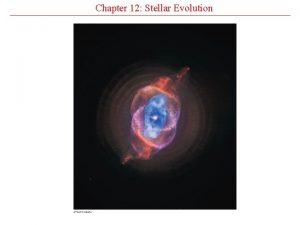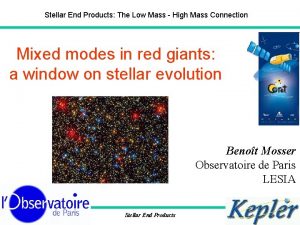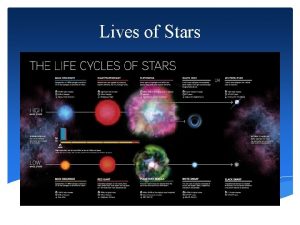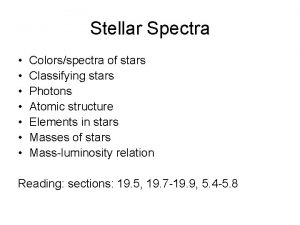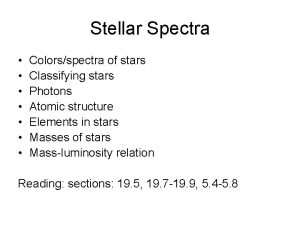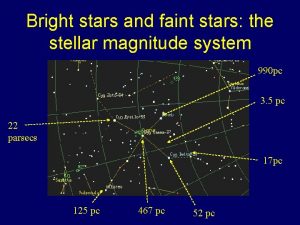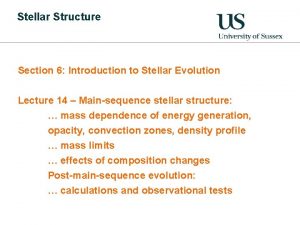Stellar Evolution Task Low Mass Stars How do





















































- Slides: 53

Stellar Evolution Task Low Mass Stars How do they evolve

100 000 Sun The evolutionary path of a low mass star m ai n se ut o d an qu en H 1 Sun ce Sun te hi w Luminosity dw f ar 0. 001 Sun r e t ar k t S as T A 40 000 K 2 500 K Surface Temperature Draw the path from main sequence to white dwarf in the HR diagram provided on the printed hand-outs NEXT

r e t ar k t S as T B What sizes can stars have Atom 0. 0000001 km Sun 700 000 km NEXT You NTU Nottingham Earth Jupiter Sun 0. 002 km 10 km 6 000 km 700 000 km Earth's Orbit 150 000 km Saturn's Orbit Solar System 1 500 000 km 6 000 000 km Next Star 40 000 000 km Galaxy 300 000 000 000 km Highlight the smallest and largest sizes of a low mass star during its evolution on the size scale on the printed hand-out d Han out

Main page of low mass evolution Redo the starter tasks to finish 100 000 Sun Learn more about Evolutionary Speed Size Evolution m se qu e 1 Sun nc e Colour Change te hi w Some Questions on Some further images low mass evolution and information on evolutionary stages dw f ar 0. 001 Sun Luminosity ai n 40 000 K 2 500 K Surface Temperature

100 000 Sun The evolutionary path of a low mass star m ai n se ut o d an qu en H 1 Sun ce Sun te hi w Luminosity dw f ar 0. 001 Sun r e t ar k t S as T A 40 000 K 2 500 K Surface Temperature Draw the path from main sequence to white dwarf in the HR diagram provided on the printed hand-outs NEXT

r e t ar k t S as T B What sizes can stars have Atom 0. 0000001 nm Sun 700 000 km NEXT You NTU Nottingham Earth Jupiter Sun 0. 002 km 10 km 6 000 km 700 000 km Earth's Orbit 150 000 km Saturn's Orbit 150 000 km Solar System 1 500 000 km Next Star 40 000 000 km Galaxy 300 000 000 000 km Highlight the smallest and largest sizes of a low mass star during its evolution on the size scale on the printed hand-out d Han out

Stellar Evolution Task That's all on low mass stellar evolution !

A low mass star in the HR diagram 100 000 Sun Time m se qu e 1 Sun nc e Main sequence te hi w dw f ar 0. 001 Sun Luminosity ai n 40 000 K NEXT 2 500 K Surface Temperature Play

A low mass star in the HR diagram 100 000 Sun Time m se qu e 1 Sun nc e Subgiant branch te hi w dw f ar 0. 001 Sun Luminosity ai n 40 000 K 2 500 K Surface Temperature Previous NEXT Play

A low mass star in the HR diagram 100 000 Sun Time m se qu e 1 Sun nc e Red Giant Branch te hi w dw f ar 0. 001 Sun Luminosity ai n 40 000 K 2 500 K Surface Temperature Previous NEXT Play

A low mass star in the HR diagram 100 000 Sun Time Helium Flash m se qu e 1 Sun nc e te hi w dw f ar 0. 001 Sun Luminosity ai n 40 000 K 2 500 K Surface Temperature Previous NEXT Play

A low mass star in the HR diagram 100 000 Sun Time m 1 Sun Horizontal se Branch qu en ce te hi w dw f ar 0. 001 Sun Luminosity ai n 40 000 K 2 500 K Surface Temperature Previous NEXT Play

A low mass star in the HR diagram 100 000 Sun Time Asymptotic Giant Branch m se qu e 1 Sun nc e te hi w dw f ar 0. 001 Sun Luminosity ai n 40 000 K 2 500 K Surface Temperature Previous NEXT Play

100 000 Sun A low mass star in the HR diagram Time Planetary Nebula m se qu e 1 Sun nc e te hi w dw f ar 0. 001 Sun Luminosity ai n 40 000 K 2 500 K Surface Temperature Previous NEXT Play

A low mass star in the HR diagram 100 000 Sun Time m se qu e 1 Sun nc e te hi w dw f ar 0. 001 Sun Luminosity ai n 40 000 K 2 500 K Surface Temperature Previous Return to Main Page Play

100 000 Sun A low mass star in the HR diagram m se qu e 1 Sun nc e Size Main sequence te hi w dw f ar 0. 001 Sun Luminosity ai n 40 000 K NEXT 2 500 K Surface Temperature Play

100 000 Sun A low mass star in the HR diagram m se qu e 1 Sun nc e Size Subgiant branch te hi w dw f ar 0. 001 Sun Luminosity ai n 40 000 K 2 500 K Surface Temperature Previous NEXT Play

100 000 Sun A low mass star in the HR diagram m se qu e 1 Sun nc e Red Giant Branch Size te hi w dw f ar 0. 001 Sun Luminosity ai n 40 000 K 2 500 K Surface Temperature Previous NEXT Play

100 000 Sun A low mass star in the HR diagram Size Helium Flash m se qu e 1 Sun nc e te hi w dw f ar 0. 001 Sun Luminosity ai n 40 000 K 2 500 K Surface Temperature Previous NEXT Play

100 000 Sun A low mass star in the HR diagram Size m 1 Sun Horizontal se Branch qu en ce te hi w dw f ar 0. 001 Sun Luminosity ai n 40 000 K 2 500 K Surface Temperature Previous NEXT Play

100 000 Sun A low mass star in the HR diagram m se qu e 1 Sun nc e te hi w dw f ar 0. 001 Sun Luminosity ai n Size Asymptotic Giant Branch 40 000 K 2 500 K Surface Temperature Previous NEXT Play

A low mass star in the HR diagram 100 000 Sun Size Planetary Nebula m se qu e 1 Sun nc e te hi w dw f ar 0. 001 Sun Luminosity ai n 40 000 K 2 500 K Surface Temperature Previous NEXT Play

100 000 Sun A low mass star in the HR diagram m se qu e 1 Sun nc e te hi w Size dw f ar 0. 001 Sun Luminosity ai n 40 000 K 2 500 K Surface Temperature Previous Return to Main Page Play

100 000 Sun A low mass star in the HR diagram m se qu e 1 Sun nc e Main sequence Colour te hi w dw f ar 0. 001 Sun Luminosity ai n 40 000 K NEXT 2 500 K Surface Temperature Play

100 000 Sun A low mass star in the HR diagram m se qu e 1 Sun nc e Colour Subgiant branch te hi w dw f ar 0. 001 Sun Luminosity ai n 40 000 K 2 500 K Surface Temperature Previous NEXT Play

100 000 Sun A low mass star in the HR diagram m se qu e 1 Sun nc e Red Giant Branch Colour te hi w dw f ar 0. 001 Sun Luminosity ai n 40 000 K 2 500 K Surface Temperature Previous NEXT Play

100 000 Sun A low mass star in the HR diagram Helium Flash m se qu e 1 Sun nc e hi w Colour te dw f ar 0. 001 Sun Luminosity ai n 40 000 K 2 500 K Surface Temperature Previous NEXT Play

100 000 Sun A low mass star in the HR diagram m 1 Sun Horizontal se Branch qu en ce Colour te hi w dw f ar 0. 001 Sun Luminosity ai n 40 000 K 2 500 K Surface Temperature Previous NEXT Play

100 000 Sun A low mass star in the HR diagram Asymptotic Giant Branch m se qu e 1 Sun nc e hi w Colour te dw f ar 0. 001 Sun Luminosity ai n 40 000 K 2 500 K Surface Temperature Previous NEXT Play

100 000 Sun A low mass star in the HR diagram Planetary Nebula m se qu e 1 Sun nc e hi w Colour te dw f ar 0. 001 Sun Luminosity ai n 40 000 K 2 500 K Surface Temperature Previous NEXT Play

100 000 Sun A low mass star in the HR diagram Colour m se qu e 1 Sun nc e te hi w dw f ar 0. 001 Sun Luminosity ai n 40 000 K 2 500 K Surface Temperature Previous Return to Main Page Play

100 000 Sun Stellar evolution low mass stars quiz When has a low mass star reached its largest size? m se qu e 1 Sun nc e Click on the right region in HR diagram! te hi w dw f ar 0. 001 Sun Luminosity ai n 40 000 K 2 500 K Surface Temperature Next question Return to Main Page

Stellar evolution low mass stars quiz When has a low mass star reached its largest size? Correct! On the Asymptotic Giant Branch a low mass star has reached its largest size of ~100 times larger than our Sun. Next question Return to Main Page

Stellar evolution low mass stars quiz When has a low mass star reached its largest size? Wrong! Either try again or have another look at the size evolution slides Redo question Return to Main Page

100 000 Sun Stellar evolution low mass stars quiz Which are three longest evolutionary stages of a low mass star? m se qu e 1 Sun nc e Click on the one of the right regions in HR diagram! te hi w dw f ar 0. 001 Sun Luminosity ai n 40 000 K 2 500 K Surface Temperature Previous question Next question Return to Main Page

Stellar evolution low mass stars quiz Which are three longest evolutionary stages of a low mass star? Correct! The main sequence is the longest evolutionary phase of a low mass star. Our Sun remains for 4. 5 billion years a main sequence star. Try to find the other phases or go to the next question. Redo question Next question Return to Main Page

Stellar evolution low mass stars quiz Which are three longest evolutionary stages of a low mass star? Correct! The horizontal branch is the third longest evolutionary phase of a low mass star. Try to find the other phases or go to the next question. Redo question Next question Return to Main Page

Stellar evolution low mass stars quiz Which are three longest evolutionary stages of a low mass star? Correct! The white dwarf phase is the second longest evolutionary phase of a low mass star. Actually this isn't a real phase. It is more the like the grave of a low mass star. Try to find the other phases or go to the next question. Redo question Return to Main Page

Stellar evolution low mass stars quiz Which are three longest evolutionary stages of a low mass star? Wrong! Either try again or have another look at the evolutionary speed slides. Redo question Return to Main Page

Stellar evolution low mass stars quiz 100 000 Sun Which colour does a giant in the evolution of a low mass star have before it becomes a planetary nebula? m se qu e 1 Sun nc e Click on the right colour! te hi w dw f ar 0. 001 Sun Luminosity ai n 40 000 K 2 500 K Surface Temperature Previous question Return to Main Page

Stellar evolution low mass stars quiz Which colour does a giant in the evolution of a low mass star have before it becomes a planetary nebula? Correct! These stars are very red since they are very cool. Our Sun will become as cold as 2 500 K on its surface. Return to Main Page

Stellar evolution low mass stars quiz Which colour does a giant in the evolution of a low mass star have before it becomes a planetary nebula? Wrong! Either try again or have another look at the colour change slides. Redo question Return to Main Page

Info on low mass evolution 100 000 Sun Click on an evolutionary phase in the HR diagram you want to learn more about! 1 Sun Red Giants Horizontal Branch Planetary Nebula 0. 001 Sun Luminosity Main Page White Dwarfs 40 000 K 2 500 K Surface Temperature

Red Giants Mira Betelgeuse Info Page Red giants are sooo large that we can actually 'see' their size. Sadly we have to use very special techniques and can't just look through a very large telescope. Many bright red stars we see in the sky are red giants. NEXT

Red Giants NGC 6888 - Crecent Previous Info Page Nebula Red giants lose some of their mass during their evolution. This material can form beautiful nebula around them and also enriches the surrounding space with heavy elements. NEXT

Red Giants An artists impression of a Supernova Type Ia Info Page The Red Giant on the right is in a double star system. It provides material for a white dwarf on the left. If the white dwarf collects enough material it will explode as a Supernova (Type Ia). Since this happens at a very specific mass and the brightness depends on the mass, we can use these special Supernova to derive distances to very distant galaxies.

Horizontal Branch A HR diagram of a cluster of old Info stars Page NEXT In this figure it becomes clear why these stars are called horizontal stars: The location of all horizontal branch stars is highlighted and they all lie in a horizontal region.

Horizontal Branch Variable Horizontal branch Previous Info stars Page You will have noticed that some horizontal branch stars seemed to be above the normal region favoured by the others. These special stars are variable stars. Maybe you can spot them in the image of an old stellar cluster. These special stars are used to determine distance in our Galaxy.

Planetary Nebula M 57 - Ring nebula Info Page NEXT During the Planetary Nebula phase the star becomes a white dwarf and ejects all its mass into space. What remains is a white dwarf in the centre and a beautiful symetric nebula. It looks like a ring since the mass the star has lost is in a spherical shell around it.

Planetary Nebula NGC 6543 Previous Info Page Sometimes the mass ejected by the star interacts with the mass it has lost during the Red Giant Phase and creates more complicated patterns. Here the nebula actually consists of two sperical shells. one to the top left and one to the bottom right of the star. NEXT

Planetary Nebula Previous Info Page In some cases the two spherical shells look as if they are open at each end.

White Dwarfs White dwarfs in an old stellar cluster Info Page White dwarfs are difficulat to observe since they are the faintest phase in the low mass stars evolution. However you will end up with loads of them after a while in an old cluster. NEXT

White Dwarfs An artists impression of Supernova Type Ia Previous Info Page a The Red Giant on the right is in a double star system. It provides material for a white dwarf on the left. If the white dwarf collects enough material it will explode as a Supernova (Type Ia). Since this happens at a very specific mass and the brightness depends on the mass, we can use these special Supernova to derive distances to very distant galaxies.
 Flowchart of the life cycle of a star
Flowchart of the life cycle of a star Stellar evolution diagram
Stellar evolution diagram Zero age main sequence
Zero age main sequence Stellar evolution
Stellar evolution Stellar evolution
Stellar evolution Stellar evolution
Stellar evolution Stellar evolution diagram
Stellar evolution diagram There are millions of stars in the sky
There are millions of stars in the sky Life cycle of a small/medium star
Life cycle of a small/medium star Star with small and medium mass
Star with small and medium mass Mid = low + (high - low) / 2
Mid = low + (high - low) / 2 Communication style bias
Communication style bias Significant figures
Significant figures Low voltage = low hazard
Low voltage = low hazard Ipde process
Ipde process What is a low floor high ceiling task
What is a low floor high ceiling task Tiered task bias task
Tiered task bias task Stellar heaven
Stellar heaven Mizar luminosity
Mizar luminosity Stellar motion matlab
Stellar motion matlab Virgo stellar stream
Virgo stellar stream Masses in the stellar graveyard
Masses in the stellar graveyard Iptv hosting
Iptv hosting Stellar assessment
Stellar assessment Stellar saga
Stellar saga What is stellar parallax?
What is stellar parallax? Stellar
Stellar Stellar formation
Stellar formation Stellar asset management
Stellar asset management Becquerel
Becquerel Stellar wifi
Stellar wifi Stellar alchemy
Stellar alchemy Virginia's 3 major watersheds
Virginia's 3 major watersheds Very high mass star life cycle
Very high mass star life cycle Types of fronts
Types of fronts How to solve stoichiometric calculations
How to solve stoichiometric calculations Label the parts of atom
Label the parts of atom Relative formula mass of hcl
Relative formula mass of hcl Percentage composition by mass
Percentage composition by mass Inertial mass vs gravitational mass
Inertial mass vs gravitational mass Grams to moles conversion
Grams to moles conversion How to convert mass to moles
How to convert mass to moles Molar mass def
Molar mass def Atomic mass vs molar mass
Atomic mass vs molar mass Read pp
Read pp Mass/mass problems
Mass/mass problems Difference between atomic mass and atomic number
Difference between atomic mass and atomic number Gravitational mass vs inertial mass
Gravitational mass vs inertial mass Formula mass
Formula mass Cl- molar mass
Cl- molar mass Atomicity table
Atomicity table Formula mass vs molar mass
Formula mass vs molar mass How to find percent concentration
How to find percent concentration Inertial mass vs gravitational mass
Inertial mass vs gravitational mass

